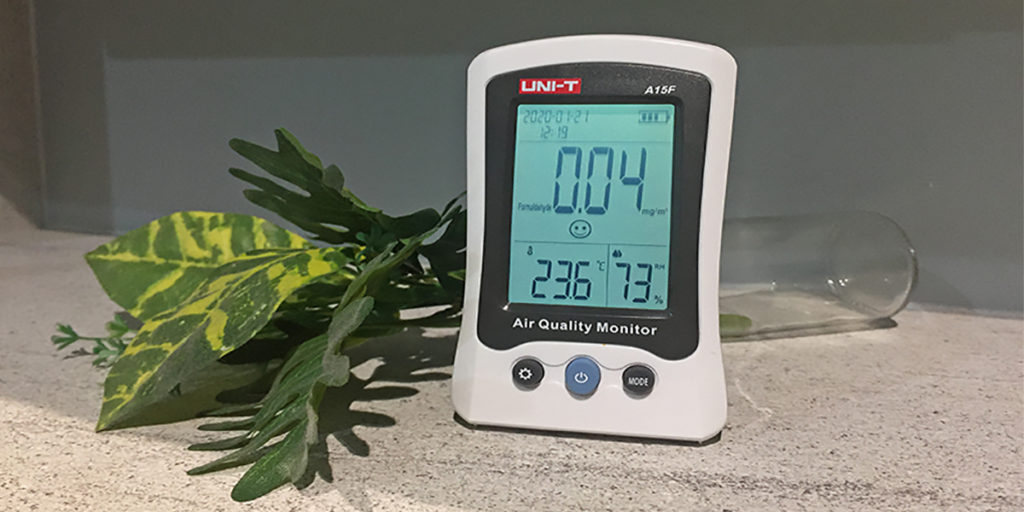Ahh, home sweet home! But Wait. What’s that new house smell? And why is it itching my eyes and nose? These might be signs your home has hazardous levels of formaldehyde.
On 9 October 2019, Singapore Chinese newspaper, Zaobao, reported a formaldehyde poisoning incident. A couple immediately smelled something was amiss in their new home. Following an air quality check, the couple was surprised to find that formaldehyde levels were dangerously high. To compensate the bodily harm inflicted, the couple received SGD 42 000 as ordered by the State Courts.
Side Effects of that “New House Smell”
Clearly, the stinging sensation of your new house smell should not be ignored. Here’s why.
First of all, formaldehyde can cause cancer.
Secondly, as a volatile organic compound (VOC), it lingers in the atmosphere long after it has been released. Since VOCs evaporate quickly at room temperature, its characteristic acrid odor is smelled immediately and for long. A good example is cigarette smoke which contains formaldehyde. It stays on a smoker’s fingers and clothing long after they’ve snuffed butt.
In other words, you’re perpetually at risk of contracting cancer in your own home. In the short run, you may experience watery eyes; a burning sensation in the eyes, nose and throat; nausea; coughing and wheezing; and rashes. And if unremedied, experts say there is irrevocable damage to the organs and nervous system.
According to the World Health Organization, an indoor environment with more than 0.1 mg per m3 of formaldehyde is toxic. Singapore’s Workplace Safety and Health Regulations sets a higher threshold of 0.37 mg per m3. If you’re unsure if your air is safe, an air quality monitor will do the trick.
If Formaldehyde is Bad for Us, Why Use It?
According to a report by the OECD, formaldehyde is an indispensable chemical because of its various applications. It sanitises, preserves and is essential in the manufacturing of resins.
In the building and construction industries, formaldehyde is a base ingredient in adhesives and resins. Resins and glues coat and hold together plywood, laminates, medium-density fiberboards (MDF) and oriented strand boards (OSB). Even paint and building materials for ceiling and partition boards require it as an essential manufacturing ingredient. Without formaldehyde, furnishing products might not be as durable.
Building and construction related companies aren’t the only ones using the toxic chemical. Unsuspecting products include pest control chemicals, air-fresheners (scented candles included) and cosmetic products. Perhaps a more, or rather, only, “acceptable” use of it is in the embalming fluid for cadavers.
Are there Alternatives to Formaldehyde Laden Products?
Since we’re far from dead, living in a home where there’s an unbending compromise between health and durability seems unthinkable. Having to make the compromise at all is absurd.
Thankfully, advancements in technology have developed formaldehyde-free and low VOC emission materials. Singaporean can easily recognize this by the Green Label or the Singapore Green Building Product Certification.
The Green Label is an identifiable consumer logo certifying a product’s eco-friendliness. Product categories like carpets, panel boards and even furniture made from recycled materials must meet the given criteria. At present, over 2000 Green Label certified products exist. So, there are tons of options for homeowners to choose from!
At an industry wide level, the Singapore Green Building Product Certification determines a product’s sustainability. To qualify, every certified product used must contribute to a building’s overall sustainability rating. Each product is assessed for their environmental properties and performance. If your home renovation project requires a major building overhaul, this certification system might be more relevant.
How to Avoid (or Reduce) that New House Smell
Avoiding non-certified products is the easiest way to prevent inhaling excessive amounts of formaldehyde. But if you can’t spot the labels mentioned, here are our top tips:
- Do a little research and ask retailers what goes into the manufacturing home products. Always opt for low-VOC and low-formaldehyde products.
- Pay special attention when purchasing wooden furniture.
- If you’re purchasing wooden furniture or wallpaper off Taobao, look out for the China Environmental Labelling certification. Under the certification program, each product must meet environmental criteria in the manufacturing, usage and disposal processes.
- For customised carpentry projects, avoid manufactured wood products like plywood or MDF boards. Opt for hardwood instead. Furthermore, certain laminates applied to cabinets or for flooring can be harmful. Ensure your carpenter uses glue with low or no VOC emissions.
- Choose Green paint. Local paint producer Gush manufactures Green paint which keeps the air clean. As a bonus, the production process minimizes carbon emissions. Moreover, the specially formulated paint also helps to regulate room temperature, keeping it cool!
What if you’re already in the thick of the stuffy problem?
It’s not too late to remedy the problem. Try using an air purifier with an activated carbon filter or air-purifying plants. Take note, however, that the effect is limited.
For a more efficacious treatment, engage an Indoor Air Quality Consultant for help. Their specialised machines with HEPA filters can scrub the air clean.
Although some might recommend simply ventilating the room, we’d recommend against it. It can take up to 3 months of airing to be completely rid of the pollutant.
Good air quality at home is important for you and your family’s health. Don’t ignore that new house smell!


